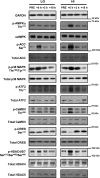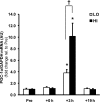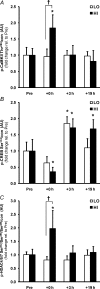Exercise intensity-dependent regulation of peroxisome proliferator-activated receptor coactivator-1 mRNA abundance is associated with differential activation of upstream signalling kinases in human skeletal muscle
- PMID: 20308248
- PMCID: PMC2887994
- DOI: 10.1113/jphysiol.2010.188011
Exercise intensity-dependent regulation of peroxisome proliferator-activated receptor coactivator-1 mRNA abundance is associated with differential activation of upstream signalling kinases in human skeletal muscle
Abstract
Skeletal muscle contraction increases intracellular ATP turnover, calcium flux, and mechanical stress, initiating signal transduction pathways that modulate peroxisome proliferator-activated receptor gamma coactivator-1alpha (PGC-1alpha)-dependent transcriptional programmes. The purpose of this study was to determine if the intensity of exercise regulates PGC-1alpha expression in human skeletal muscle, coincident with activation of signalling cascades known to regulate PGC-1alpha transcription. Eight sedentary males expended 400 kcal (1674 kj) during a single bout of cycle ergometer exercise on two separate occasions at either 40% (LO) or 80% (HI) of . Skeletal muscle biopsies from the m. vastus lateralis were taken at rest and at +0, +3 and +19 h after exercise. Energy expenditure during exercise was similar between trials, but the high intensity bout was shorter in duration (LO, 69.9 +/- 4.0 min; HI, 36.0 +/- 2.2 min, P < 0.05) and had a higher rate of glycogen utilization (P < 0.05). PGC-1alpha mRNA abundance increased in an intensity-dependent manner +3 h after exercise (LO, 3.8-fold; HI, 10.2-fold, P < 0.05). AMP-activated protein kinase (AMPK) (2.8-fold, P < 0.05) and calcium/calmodulin-dependent protein kinase II (CaMKII) phosphorylation (84%, P < 0.05) increased immediately after HI but not LO. p38 mitogen-activated protein kinase (MAPK) phosphorylation increased after both trials (2.0-fold, P < 0.05), but phosphorylation of the downstream transcription factor, activating transcription factor-2 (ATF-2), increased only after HI (2.4-fold, P < 0.05). Cyclic-AMP response element binding protein (CREB) phosphorylation was elevated at +3 h after both trials (80%, P < 0.05) and class IIa histone deacetylase (HDAC) phosphorylation increased only after HI (2.0-fold, P < 0.05). In conclusion, exercise intensity regulates PGC-1alpha mRNA abundance in human skeletal muscle in response to a single bout of exercise. This effect is mediated by differential activation of multiple signalling pathways, with ATF-2 and HDAC phosphorylation proposed as key intensity-dependent mediators.
Figures


 . See text for abbreviations and antibody descriptions.
. See text for abbreviations and antibody descriptions.



Comment in
-
Intensity-dependent activation of intracellular signalling pathways in skeletal muscle: role of fibre type recruitment during exercise.J Physiol. 2010 Nov 1;588(Pt 21):4073-4. doi: 10.1113/jphysiol.2010.195925. J Physiol. 2010. PMID: 21037317 Free PMC article. No abstract available.
References
-
- ACSM. American College of Sports Medicine Position Stand. The recommended quantity and quality of exercise for developing and maintaining cardiorespiratory and muscular fitness, and flexibility in healthy adults. Med Sci Sports Exerc. 1998;30:975–991. - PubMed
-
- Akimoto T, Pohnert SC, Li P, Zhang M, Gumbs C, Rosenberg PB, Williams RS, Yan Z. Exercise stimulates Pgc-1α transcription in skeletal muscle through activation of the p38 MAPK pathway. J Biol Chem. 2005;280:19587–19593. - PubMed
-
- Akimoto T, Sorg BS, Yan Z. Real-time imaging of peroxisome proliferator-activated receptor-γ coactivator-1α promoter activity in skeletal muscles of living mice. Am J Physiol Cell Physiol. 2004;287:C790–C796. - PubMed
Publication types
MeSH terms
Substances
LinkOut - more resources
Full Text Sources
Medical

